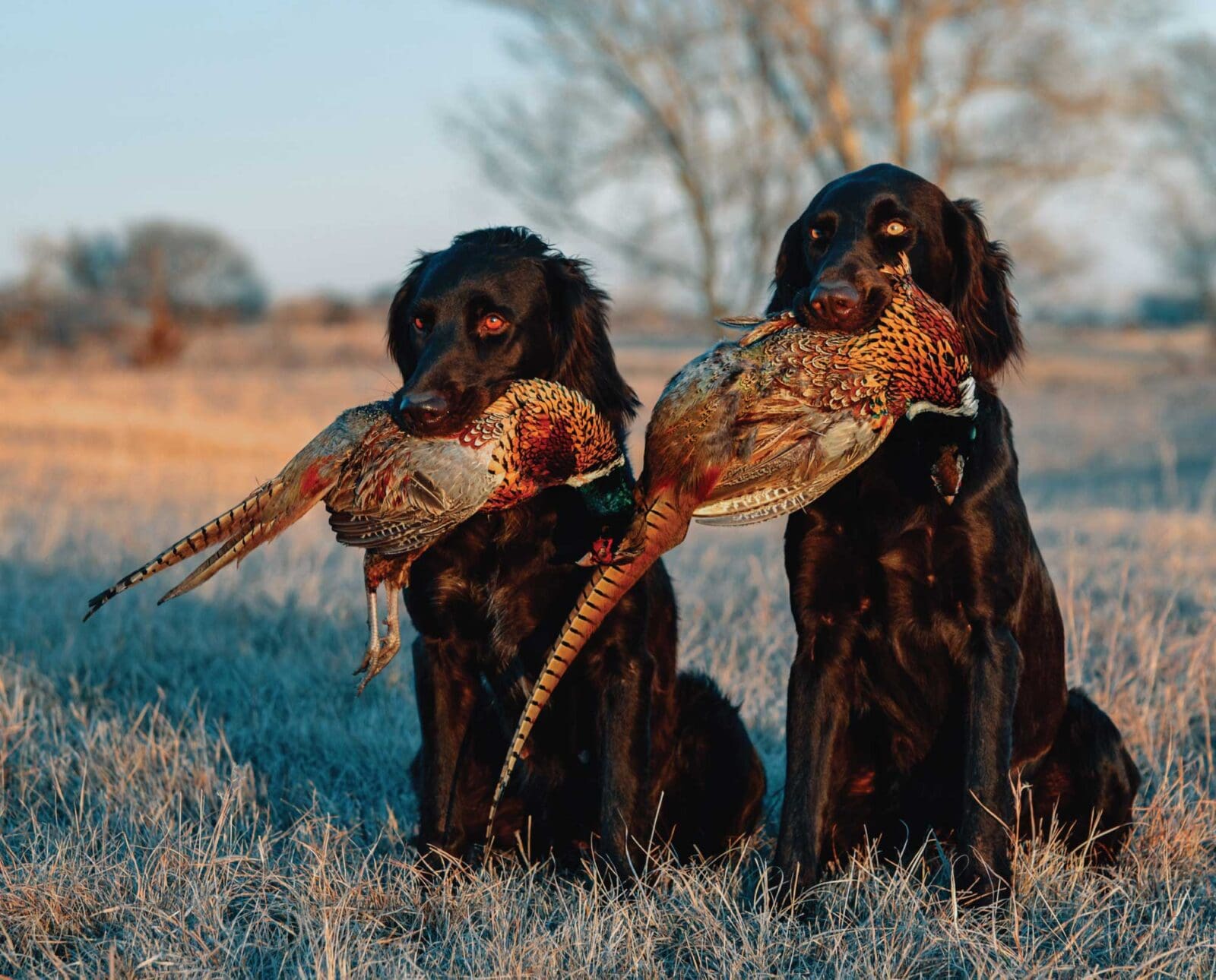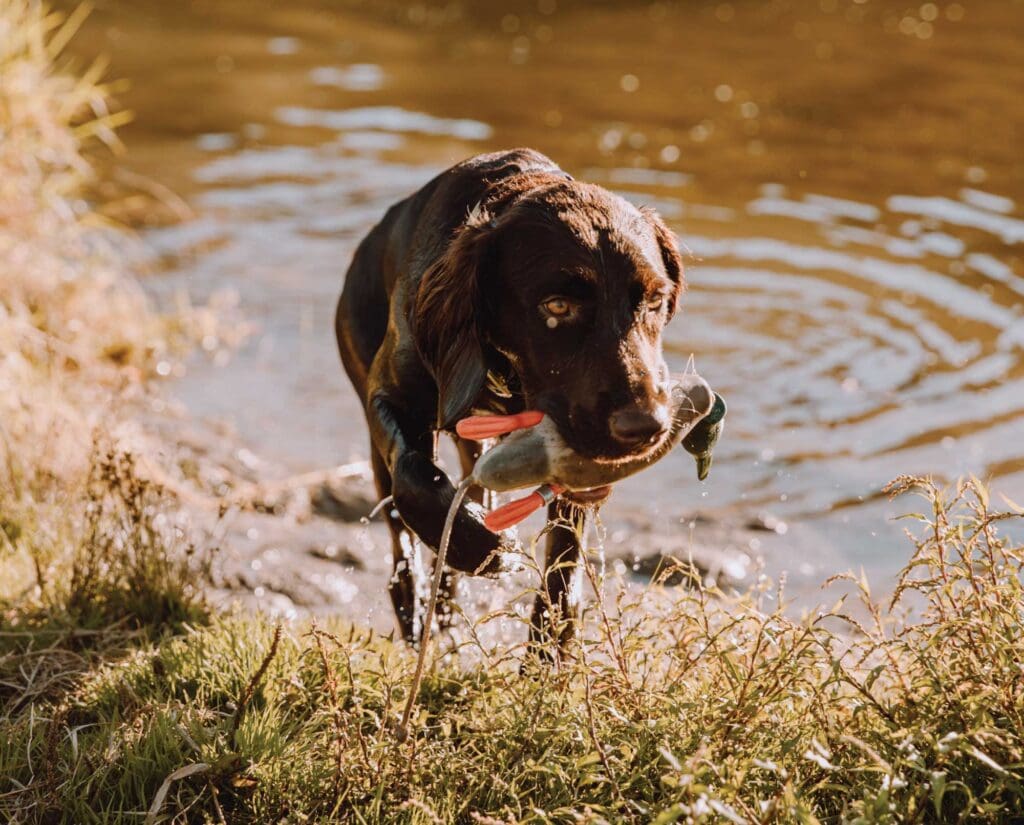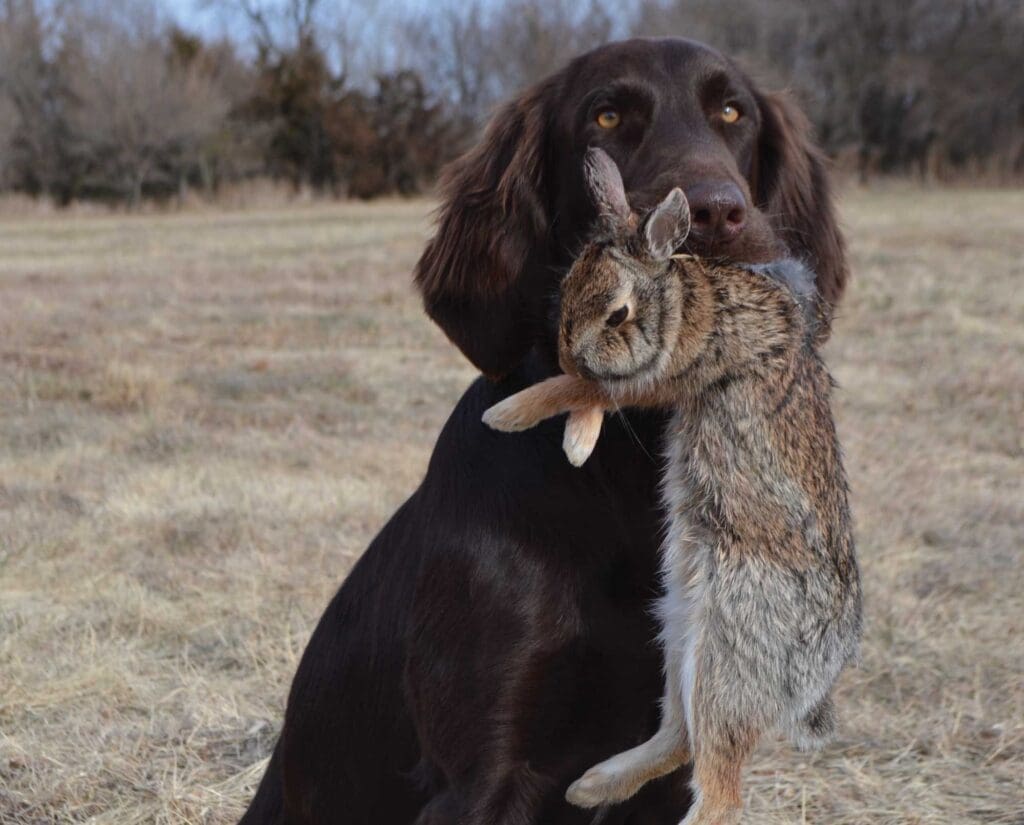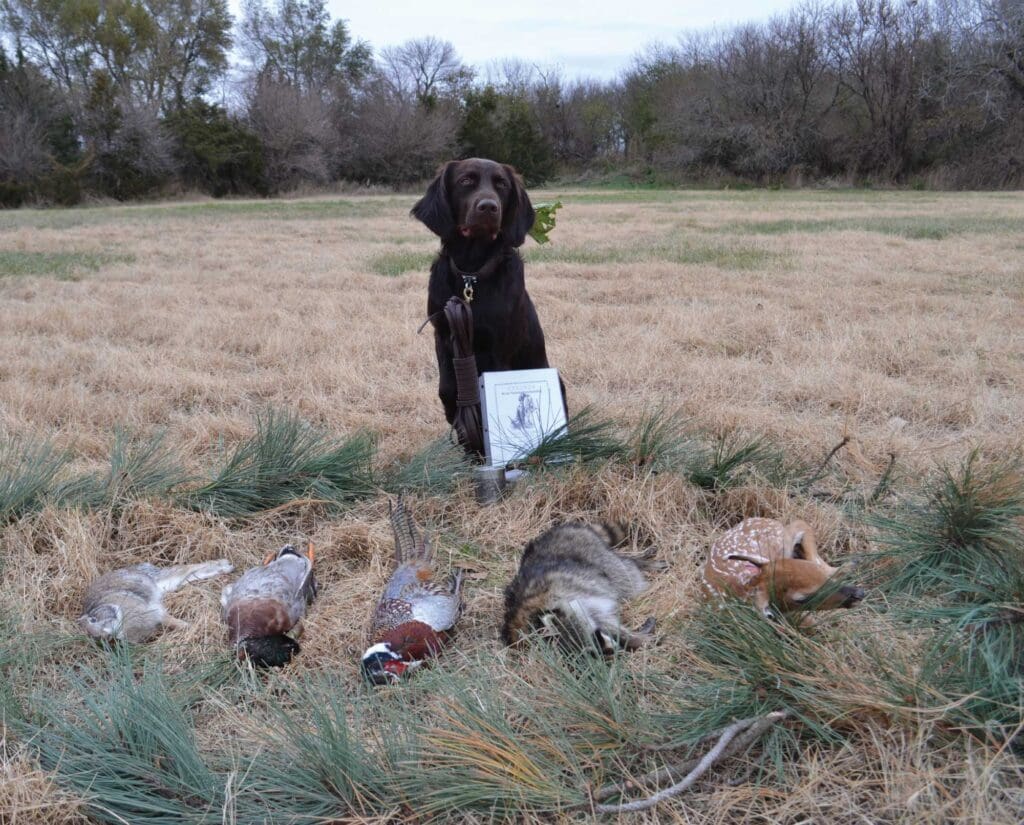Home » Hunting Dogs » The Jagdgebrauchshundverband ( JGHV) – the German Versatile Hunting Dog Association
The Jagdgebrauchshundverband ( JGHV) – the German Versatile Hunting Dog Association

Learn how the German hunting dog testing system works and how it built the breeds we love in the United States
During a beautiful fall day in Wyoming, one of the Verbands-Gebrauchs-Prüfung (VGP) judges advised me to handle my dog just like we were hunting. I did as I was instructed, but I had to chuckle a little to myself. I was handling a 15-month-old Deutsch Langhaar in this hunt test who wasn’t yet old enough to have a full hunting season under her collar. Maizey had been whelped in June of the previous summer. I had taken her out toward the end of the season to hunt for pheasants and quail in Nebraska, but she had only been about six months old at the time. She had a few points on hen pheasants and quail and she’d made a few quail and rabbit retrieves for me. But here I was, running her in the most demanding gundog test in the world with virtually no real hunting experience. It is in these moments when I really come to understand the incredible value of breeding standards that include a performance element. Thanks to a century of strict testing and breeding requirements, Deutsch Langhaars today have not only a ton of natural hunting ability, but also a high degree of trainability. When the scores were read the next day, Maizey had passed the test with 295 points out of a possible 312 and a Prize II rating. She was the highest-scoring dog of the weekend and became the youngest Deutsch Langhaar in North American history to pass the VGP.
Listen to more articles on Apple | Google | Spotify | Audible
Maizey is the ninth Deutsch Langhaar that I have run in a VGP and definitely not the most talented dog I’ve ever trained, nor am I an expert trainer by any means. Instead, Maizey is the product of a system that has followed strict regulations for over a hundred years to produce dogs that are capable of handling anything they may encounter during hunting season. The VGP in particular is a great way to measure a dog’s preparedness for hunting season by evaluating the dog for two full days in a wide variety of field, forest, and water hunting scenarios. As a hunter, there are few feelings better than walking away from a VGP with finished gundog just as hunting season is getting underway.
Our bird season was full of highs and lows, just like any season of chasing birds in the field. Maizey improved a great deal as she gained practical experience on wild birds. But the best thing about hunting with a finished and proofed dog like Maizey is how relaxing it can be. I do not have to worry about whether she is going to bump birds. I do not have to worry about whether she will find and retrieve a downed bird to hand. I do not have to whistle or call her to keep her hunting with me. I never have to wonder how she is going to react to hunting with different people or dogs. I don’t even have to wonder if she is going to whine or bark in the truck should I decide to rotate her out and hunt with another dog. She is a finished dog that I can completely rely on in any circumstances. That purpose-driven outcome is the primary value of a testing system with specific deadlines and clear requirements for passing tests.
The Levels of Testing within the German Versatile Hunting Dog System
The Jagdgebrauchshundverband ( JGHV) is the German versatile hunting dog association that conducts performance hunt tests for the purpose of evaluating several different gundog breeds, including versatile dogs in North America. It is up to the individual breed clubs to decide which of those tests will be considered requirements prior to breeding an eligible dog. For the Deutsch Langhaar, the parent breed club in Germany requires passing scores on the first two levels of JGHV testing, in addition to a few other requirements, before a Deutsch Langhaar can be certified for breeding.
The Verbands-Jungend-Prüfung (VJP) – Spring Puppy Test
The first level of JGHV testing is the Verbands-Jungend-Prüfung (VJP), or the Spring Puppy Test, which is a natural ability test held each spring. In this test, Deutsch Langhaars and other German-bred dogs are evaluated on their ability to search, point, and track. Nose and cooperation are also scored. The dog’s reaction around gunfire is assessed. It is preferred to have all search and pointing work done on wild game, but many test sites in the country require that liberated birds are used for pointing evaluation. The tracking must be done on wild, furred game which, in North America, is typically cottontail rabbits or jackrabbits. The overall focus of this test is on a dog’s natural ability.
During the course of the VJP, and again at every level of JGHV testing, the dog’s temperament is evaluated throughout the day. Dogs can be marked as impassive, calm, lively, or restless. If a dog is marked as being shy or aggressive towards dogs or people, that dog is automatically disqualified from breeding, regardless of how well he or she may score in the test.
The Verbands-Herbstzucht-Prüfung (HZP) – Fall Breed Test
The second level of JGHV testing is the Verbands-Herbstzucht-Prüfung (HZP), or Fall Breed Test, which is an advanced natural ability test held each fall. In this level of testing, dogs are evaluated on their ability to search, point, and retrieve. Nose, desire, and cooperation are also scored. The dog’s reaction around gunfire is measured on land and in the water. In the field, dogs are expected to hold point until their handler is within gun range. We want to know that the dog points well enough to have birds effectively shot over them. The rest of the test is comprised of two land retrieves: one 200m duck or pheasant track and retrieve and one 300m rabbit track and retrieve; and three water retrieves: one marked retrieve of a dead duck, one blind retrieve of a dead duck, and one search behind a live duck. The overall focus of this test is split between the dog’s natural ability, particularly on subjects such as the search behind the duck, and the dog’s trainability for the retrieves, especially out of sight of the handler when completing the long tracks.
The Verbands-Gebrauchs-Prüfung (VGP) – Utility Test
The third level of JGHV testing is the Verbands-Gebrauchs-Prüfung (VGP), or Utility Test, which is held each fall and truly measures the finished gundog. In this level of testing, dogs are evaluated in 26 subjects across four major categories: Field, Water, Forest, and Obedience. Basically, the dogs are expected to be steady to wing and shot in the field, able to complete multiple blind retrieves at the water, able to blood track, able to complete both cooperative and independent searches in the woods, able to retrieve all manner of feathered and furred game (including a predator such as a raccoon or fox), and they must be obedient and mild-mannered while performing and between tasks. The VGP covers such a breadth of subjects that it is difficult to pinpoint an overall focus other than to say that a dog must have a balanced temperament, a lot of natural ability, and a high level of trainability to pass this test.

Timing of Testing and the Influence on Maturity Rates
JGHV testing is similar to horse racing in that dogs are required to complete these tests based on when they were whelped. A typical puppy whelped in the Spring of 2020 would need to run in their VJP in the Spring of 2021 and their HZP in the Fall of 2021. The VGP is an optional test that can be run at any time.
The timing is important for two reasons. The first is that the testing system was set up with hunting first and foremost in mind. In order to prepare your pup for his or her first hunting season, they should be showing some strong pointing and tracking instincts in the spring after they were whelped. You then have that whole summer to complete a trained retrieve program with your dog and get them comfortable with blind retrieves in the water. Immediately following the HZP, typically held in September or October, you are ready to hunt with a dog that you can comfortably shoot over and that you can trust to retrieve game.
The other reason why test timing is important is because it promotes fast-maturing dogs. When every dog in the breed has to pass an HZP before they turn two years of age, it ensures that we are only breeding dogs that are trainable. It does take a certain mental toughness for a dog to be able to take the pressure of the trained retrieve or steadiness training. Personally, I believe that our dogs’ lives are too short to wait for a slow-maturing dog to be able to handle advanced dog training, so I love that the JGHV system promotes getting young dogs trained early and then out hunting effectively at a young age.
Another limiting factor is that each dog is only allowed to run a maximum number of two times in each level of testing. Why give the dogs only two chances to pass each test? The reason for limiting test opportunities to just two attempts is to ensure that dogs are being fairly evaluated on their innate abilities. Even the best dog can have an off-day or have something unusual come up on test day, so the second chance is certainly understandable. But if a dog cannot pass a given level of testing within two attempts, then that dog is not eligible for breeding. The dog will probably still be an excellent hunting dog for his or her handler, but when we are looking at which dogs we want to contribute to the next generation of our breed, trainability has to be a priority. If the dog cannot be trained to a point where he or she can pass an HZP within two attempts before he or she turns two years of age, then that dog is not a suitable breeding candidate. We may never know if the dog or the handler was at fault for failing, but for the purposes of breeding, we strive to produce dogs that will be easier to train for the next generation of handlers.

The Role of Testing in the Continued Development of German Dogs
The Deutsch Langhaar Verband requires every Deutsch Langhaar to pass the VJP and HZP before they can be certified for breeding. This ensures that all Deutsch Langhaars not only have a lot of natural ability, but that they are also very trainable and fast-maturing dogs. The VGP is highly encouraged, both as a measure of the dog but also for the incredible benefit of preparing both handler and dog for exceptional hunting seasons in the future. Selectively breeding dogs for the purpose of hunting is always very challenging. Because there are so many genes involved, you never know exactly what you are going to get from a particular pairing. But by requiring that all of the dogs in the entire pedigree have passed at least the VJP and HZP, it is reasonably certain that every Deutsch Langhaar puppy whelped in North America will point, track, and retrieve on land and water.
The value of testing goes beyond just achieving breeding certification, too. We emphasize testing every puppy in the litter, not just the ones that people are planning to breed, because the performance data of the litter gives valuable feedback on the relative success of that particular pairing. Since the Deutsch Langhaar-Gruppe Nordamerika (DL-GNA) was founded in 2008, 53% of all Deutsch Langhaar pups whelped in the US and imported from Germany have been run through a VJP. Astonishingly, one hundred percent have passed! That is an incredible statistic. A Deutsch Langhaar has never failed a JGHV natural ability test for not pointing or tracking. Further research shows that no Deutsch Langhaar has ever failed a natural ability test in the North American Versatile Hunting Dog Association (NAVHDA) or the Versatile Hunting Dog Federation (VHDF) system, either. To put it simply, all Deutsch Langhaars point and track, which is a true testament to the value of the JGHV system and strict breeding regulations that have been built around it.
Since 2008, 33% of Deutsch Langhaars whelped in the US or imported from Germany have completed the HZP with a passing rate of 79%. This means that about a third of Deutsch Langhaar pups go into their first or second hunting season as reliable retrievers on land and water, in addition to their natural abilities in search and pointing. Further, 10% of Deutsch Langhaars have completed the VGP with an 84% passing rate. What’s even better news is that the number of dogs entering and passing VGPs continues to climb each year. As the DL-GNA breed warden and advocate for the breed, it is exciting that 1 in 10 Deutsch Langhaar pups whelped in the US or imported as a pup from Germany are currently going on to complete the VGP and, ultimately, to hunt as truly finished gundogs.
The HZP and VGP numbers are the most exciting to me, not because of breeding, but because of hunting. In America, the focus often is placed on the dog’s work before the shot. Attributes such as a big-running search, a 12 o’clock tail, or a “cleaner” colored coat are often valued most. But the JGHV focuses much more on the recovery of game after the shot. JGHV testing, and therefore the Deutsch Langhaar Verband breeding requirements, focus much more on tracking ability, a calm and focused demeanor, and persistence in the pursuit of game. As a wildlife biologist, I find that ethical mentality very appealing. Research shows that most of the birds we cripple will perish within a few days from wounds and/or starvation. I value a humane harvest without animals suffering for any length of time. I love seeing a dog on point as much as the next person, but nothing compares to that mixed feeling of excitement and relief when your dog finds wounded or dead game that you could not have recovered without them. I have gotten goosebumps when my dogs recover deer after any length of blood track and I have nearly cried in relief when my dogs have brought back a goose or pheasant that I thought was lost.

Why Performance Testing Matters to the Average Hunter
Despite the number of hunters declining around the country, the number of people hunting with German-bred dogs, including the Deutsch Langhaar, is growing. Hunters are seeing the value in fast-maturing, easily trainable gundogs that can transition easily between being family pets and passionate hunters. Versatile dogs are becoming increasingly popular as hunters realize that a dog bred for feather and fur, before and after the shot, means more harvest opportunities and more meat in the freezer. Ten years ago, everyone that contacted us about a puppy was a bird hunter. Now, some of the people that contact us are specifically looking for a dog with which they can recover deer and nearly everyone looking for a puppy hunts some sort of furred game in addition to feathered game. The comprehensive German testing system has enabled the Deutsch Langhaar breed to become one of the most consistently talented breeds of gundog today. You can pick a Deutsch Langhaar pup out of any litter in America or Germany and know that your pup is going to point, track, and retrieve on land and water. There is also consistency in the health, temperament, and conformation of the breed, thanks to strict breeding standards in those areas as well.
Whenever you get a new puppy, you are getting a bundle of potential. Most of us do not have unlimited time and resources to develop that pup into our dream gundog, so it is really important to stack the deck as much as possible and start out with a well-bred puppy that just needs more exposure than actual training. We all want a puppy with a ton of natural pointing/tracking/retrieving instinct. We all want a puppy who can live a long, healthy life. And most of us want a pup with a cooperative temperament who is easy to train. Thanks to the rigorous testing and breeding system put into place by those who came before us and upheld by enthusiasts today, the Deutsch Langhaar is an incredibly consistent breed in temperament, health, and performance.
All of the training and testing can seem intimidating at times. A good friend and I are always joking about how we “just wanted a cute puppy,” and now we have extra freezers full of training game, flight pens to hold live birds, and are giving up many weekends in the spring and fall to test or judge dogs. But because of those efforts, we ended up with really talented gundogs that are beloved family members as well.
On opening weekend of the 2020 pheasant and quail season in Nebraska, Maizey and I were hunting alone at a Waterfowl Production Area that I had not been to before. We had walked for about 45 minutes in well-above-average hunting temperatures without any sign before Maizey locked up on point near the end of a shelterbelt. She held staunch as I approached and suddenly a covey of twenty bobwhite quail flew out in all directions. I picked out one bird and shot. The quail dropped to the ground. Maizey quickly found it and sat to retrieve it to hand. We continued hunting in the direction where several of the quail had flown to look for singles. Maizey went on point again at the end of some taller grass, where I flushed the single quail and dropped it. On her way to find that bird, Maizey locked up on point yet again. I was not sure if she was pointing the shot bird or another quail, so I cautiously approached with my hands at the ready position on my wellworn over under. Right as I stepped in front of Maizey, a single quail rocketed out of the grass. I raised my gun and fired; that bird also dropped. Maizey had a good mark and she quickly found that quail and retrieved it to hand. But that meant that I had dropped three quail and yet only had two birds in the bag. There had to be one still hiding in the tall, dense, warm season grass. Maizey was panting pretty hard from her efforts so I put her on a down with some water to relax and cool off while I attempted to locate the final quail on my own.
After several minutes of searching the area in a grid pattern, I was not having any luck. Maizey looked like she was rested so I sent her into the heavy grass cover with a blind retrieve command. Not one minute after I sent her, she was on point again. This time, her head was pointing straight down into the grass directly beneath her. She held tight while I walked in front of her. Rather than trying to flush anything, I kneeled down and gently parted the grass. Sure enough, tucked down deep underneath thick layers of grass was a single live quail. With daylight now shining on it, the bird leapt into the air in an attempt to flush, but my earlier shot had rendered it flightless. I released Maizey with a tap on the back of her head and she launched into the cover to grab the wounded bird. Then she proudly trotted up to me to sit and deliver to hand. We ended up harvesting a pair of rooster pheasants and another quail from a different covey as we finished hunting that property, but that sequence of Maizey’s work on that first covey and the two singles afterward is what I will remember for a long time. I would never have found that live quail without a dog. To see her handling all of that excitement with all of those birds on the opening weekend of her first real hunting season, while maintaining all of her steadiness and retrieving manners, was impressive. I am grateful to the JGHV testing system and to the Deutsch Langhaar Verband breeding requirements that ultimately gave me that wonderful experience with a 17-month old Deutsch Langhaar. Because of that, I am genuinely excited to hunt with Maizey and our other Deutsch Langhaars knowing how relaxed and enjoyable the hunting will be with talented and capable dogs that I trust completely to find and recover game.




To be more accurate, temperament is simply “notated” at the performance tests and on the final score sheets…
The true and final evaluation of temperament is actually at the Zuchtschau (breed show) and is incorporated into the Conformation evaluation.
Each JGHV breed club chooses how to “interpret” the JGHV test results. In the DL breed, any dog marked as “restless/nervous/over-passionate”, “jumpy”, “insecure/fearful”, or aggressive towards people/dogs at any level of testing is automatically disqualified from breeding. There is no second chance for temperament at a breed show. But again, every breed club may have different rules for how they utilize data collected during JGHV tests. For example, DLs MUST pass a VJP and HZP to be certified for breeding, but no minimum score is required in the rabbit track or duck search. Meanwhile, DDs don’t actually have to pass a VJP and HZP, but rather earn at least a 6 in the hard track and duck search. And they can pass a VGP at any age to complete that duck search. Meanwhile, if a DL doesn’t pass a HZP or a VGP in the same fall it should have run a HZP, it cannot be certified for breeding. I’m sure there are other differences too between the other breeds. I wrote this article for Hunting Dog Confidential about Deutsch Langhaars a few years ago….not sure why they are republishing now.